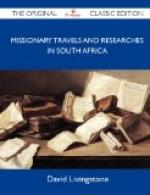The animals can be seen here only by following on their trail for many miles. Urged on by hunger, we followed that of some zebras during the greater part of the day: when within fifty yards of them, in a dense thicket, I made sure of one, but, to my infinite disgust, the gun missed fire, and off they bounded. The climate is so very damp, from daily heavy rains, that every thing becomes loaded with moisture, and the powder in the gun-nipples can not be kept dry. It is curious to mark the intelligence of the game; in districts where they are much annoyed by fire-arms, they keep out on the most open spots of country they can find, in order to have a widely-extended range of vision, and a man armed is carefully shunned. From the frequency with which I have been allowed to approach nearer without than with a gun, I believe they know the difference between safety and danger in the two cases. But here, where they are killed by the arrows of the Balonda, they select for safety the densest forest, where the arrow can not be easily shot. The variation in the selection of standing-spots during the day may, however, be owing partly to the greater heat of the sun, for here it is particularly sharp and penetrating. However accounted for, the wild animals here do select the forests by day, while those farther south generally shun these covers, and, on several occasions, I have observed there was no sunshine to cause them to seek for shade.
Chapter 16.
Nyamoana’s Present—Charms—Manenko’s
pedestrian Powers—An Idol—
Balonda Arms—Rain—Hunger—Palisades—Dense
Forests—Artificial
Beehives—Mushrooms—Villagers
lend the Roofs of their Houses
—Divination and Idols—Manenko’s
Whims—A night Alarm—Shinte’s
Messengers and Present—The proper Way to
approach a Village—A
Merman—Enter Shinte’s Town:
its Appearance—Meet two half-caste
Slave-traders—The Makololo scorn them—The
Balonda real Negroes—Grand
Reception from Shinte—His Kotla—Ceremony
of Introduction—The
Orators—Women—Musicians and
Musical Instruments—A disagreeable
Request—Private Interviews with Shinte—Give
him an Ox—Fertility
of Soil—Manenko’s new Hut—Conversation
with Shinte—Kolimbota’s
Proposal—Balonda’s Punctiliousness—Selling
Children—Kidnapping—
Shinte’s Offer of a Slave—Magic Lantern—Alarm
of Women—
Delay—Sambanza returns intoxicated—The
last and greatest Proof of
Shinte’s Friendship.
11Th of January, 1854. On starting this morning, Samoana (or rather Nyamoana, for the ladies are the chiefs here) presented a string of beads, and a shell highly valued among them, as an atonement for having assisted Manenko, as they thought, to vex me the day before. They seemed anxious to avert any evil which might arise from my displeasure; but having replied that I never kept my anger up all night, they were much pleased to see me satisfied.




